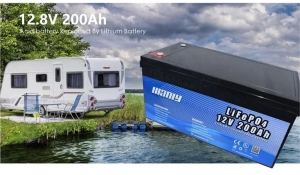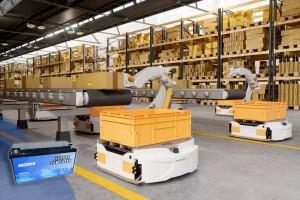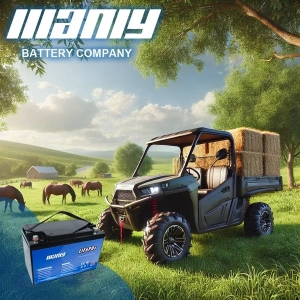¿Puedo cargar una batería de litio con un cargador normal?
Tabla de contenido
- ¿Puedo cargar una batería de litio con un cargador normal?
- Elegir el cargador de batería de litio adecuado: comprender las diferencias de carga entre las baterías de litio y SLA
- Cómo responden las baterías de litio a un perfil de carga SLA
- ¿Podría un cargador SLA dañar una batería de litio?
- ¿Puedo cargar una batería de litio con una fuente de alimentación?
- Conclusión
- Más información sobre la batería

Elegir el cargador de batería de litio adecuado: comprender las diferencias de carga entre las baterías de litio y SLA
Understanding how lithium batteries and SLA batteries absorb charge is essential when choosing the right type of cargador de batería de litio. Los perfiles de carga de estas baterías difieren significativamente. Las baterías SLA suelen seguir un proceso de tres etapas: corriente constante, voltaje constante (también llamado etapa de absorción) y carga flotante. Por el contrario, los cargadores de baterías de litio funcionan con sólo dos etapas: corriente constante y voltaje constante.Proceso de carga de batería SLA
For an SLA battery, the first stage is the constant current phase, where the battery receives most of its charge. For example, a 12V 20Ah SLA battery may take around 3-4 hours to reach 80% of its total charge capacity. Once this level is reached, the process shifts to the constant voltage or absorption stage. This stage completes the final 20% of the charge but can take as long as the first stage, making up about 50% of the total charging time. The final stage, float charging, keeps the battery at full charge to prevent self-discharge. While this helps maintain the battery’s lifespan, it also extends the total charging time.Por qué la batería de litio se carga más rápido
Charging a lithium battery is much simpler and quicker. With a lithium battery charger, the first stage (constant current) brings the battery up to 99% of its charge. The remaining 1% is topped off in the second stage, constant voltage, which is much shorter than the absorption stage used for SLA batteries. This streamlined process means lithium batteries can be fully charged up to three times faster than similar-capacity SLA batteries.For example, a 12.8V 20Ah lithium battery can reach almost full capacity in about 2.5 hours, compared to over 6.5 hours for an equivalent SLA battery. This rapid charging capability makes lithium battery chargers a popular choice for applications like golf carts, marine systems, and backup power solutions, where minimizing downtime is essential.Los perfiles de voltaje importan
One key difference between SLA and lithium batteries is their voltage profiles. A fully charged 12V SLA battery typically reaches around 12.7V, while a lithium battery can reach up to 13.4V when fully charged. This narrow voltage range in lithium batteries means that using a standard SLA charger can lead to either overcharging or undercharging. To prevent these issues, you need a universal lithium battery charger that is specifically designed to meet the precise voltage requirements of lithium batteries.The best way to charge lithium batteries is to use a dedicated li ion battery charger that follows a CC/CV (Constant Current/Constant Voltage) charging algorithm. This ensures the battery is charged safely and efficiently. Unlike SLA chargers, which may continue to trickle charge, a lithium battery charger stops charging as soon as the battery reaches full capacity, preventing potential damage from overcharging.Cómo responden las baterías de litio a un perfil de carga SLA
One common question many people have is whether a lithium battery can be safely charged using an SLA (Sealed Lead Acid) charger. The short answer is: Yes, but there are conditions. To understand why, it’s crucial to look at how lithium batteries absorb charge compared to SLA batteries, especially when using a charger designed for a different type of battery.Cómo responden las baterías de litio a los perfiles de carga SLA
The main issue when charging a lithium battery using an SLA charger is the difference in the charging curves. Most SLA chargers are set to operate at a constant voltage range between 13.8V to 14.7V. If a lithium battery is charged at the lower end of this voltage range, around 13.8V, it can still reach up to 95% of its total capacity within 90% of the total charging time. This is because the lithium battery’s internal resistance is lower, allowing it to take in more energy more quickly.However, if the charger operates at a higher voltage, around 14.6V—which is the typical voltage used for AGM batteries—the lithium battery can reach up to 99% capacity in just 95% of the charging time. This means that at higher voltages, the charging process is even more efficient, bringing the lithium battery to almost full capacity quickly.Mayor tiempo de carga con un cargador SLA
While a lithium battery can be charged using an SLA charger, the charging time will still be longer than if a dedicated lithium battery charger were used. For example, a 20Ah lithium battery might take around 2.5 hours to charge using a standard lithium battery charger. However, the same battery could take up to 5 hours to charge fully using an SLA charger. This is because the SLA charging profile is not optimized for lithium batteries, leading to less efficient absorption of energy during the constant voltage phase.Despite the longer charging time, a lithium battery will still charge faster on an SLA profile than a typical SLA battery. This is due to the nature of lithium batteries, which can absorb more energy during the bulk charging stage and require less time to reach higher states of charge. So, even with a non-optimized charger, lithium batteries still outperform their SLA counterparts when it comes to overall charging speed.Riesgos potenciales de usar un cargador SLA
Although it is technically possible to use an SLA charger for a lithium battery, there are a few important considerations. First, the SLA charger must not have a desulfation mode or a dead battery detection feature. Desulfation mode uses high voltage pulses to restore over-discharged SLA batteries. These high voltage pulses can damage a lithium battery or cause its Battery Management System (BMS) to shut down. Similarly, a dead battery detection mode might misinterpret a lithium battery in protective mode as a dead battery and fail to initiate the charging process.Additionally, the lithium battery charge voltage is more sensitive compared to SLA batteries. Using a charger that outputs voltage outside the acceptable range can harm the battery cells, leading to reduced lifespan or even permanent damage. This is why using a dedicated lithium battery charger or a universal lithium battery charger designed to handle these specific voltage requirements is always the best way to charge lithium batteries.Eficiencia de carga en diferentes rangos de voltaje
The voltage range of the SLA charger will also affect how efficiently a lithium battery charges. At the lower end of the voltage range (13.8V), the lithium battery will charge relatively quickly to 95% SOC, even faster than an SLA battery can reach 80% SOC. When charged at the higher end (14.6V), which is common for AGM batteries, the lithium battery can reach 100% SOC in a shorter time, further highlighting its superior charging capabilities compared to SLA batteries.Overall, while using an SLA charger is not ideal, it can work for charging lithium batteries if no other option is available. However, for the best results and to ensure the longevity of the battery, it’s always recommended to use a dedicated li ion battery charger that can meet the specific charging needs of a lithium battery. This approach minimizes the risks and guarantees optimal performance, making it a safer and more efficient solution in the long run.¿Podría un cargador SLA dañar una batería de litio?
If you’re using an SLA charger to charge a lithium battery, you might wonder whether it will cause damage. The answer largely depends on the specific features of the SLA charger and how the lithium battery is being used. While it is possible to use a standard SLA charger without immediate harm, several key factors must be considered to prevent long-term damage.Comprender los riesgos de utilizar un cargador SLA
The primary concern when using an SLA charger for a lithium battery is whether the charger has specific modes designed for SLA batteries, such as desulfation or float charging. Desulfation mode, which is intended to restore over-discharged SLA batteries by sending high-voltage pulses, can be highly damaging to a lithium battery. These high pulses may trigger the Battery Management System (BMS) to shut down or, in some cases, physically damage the internal battery cells.Similarly, if the SLA charger includes a float charging mode, it could potentially harm the lithium battery. This mode continuously applies a small current to the battery even after it’s fully charged, which is unnecessary for lithium batteries. Due to their low self-discharge rate, lithium batteries do not need to be kept at 100% state of charge for long periods. Therefore, exposing a lithium battery to float charging over time could reduce its overall lifespan or even lead to overheating.Capacidad limitada con un cargador SLA
One major issue you might encounter when using an SLA charger is that the lithium battery may not reach its full capacity. For example, a 20Ah lithium battery may only charge up to 90-95% of its total capacity using a standard SLA charger. This happens because SLA chargers operate at a slightly different voltage range than a lithium battery charger. This slight voltage difference means the lithium cells are not fully charged, which limits the usable capacity of the battery.If you’re using your lithium battery for a high-demand application, this could lead to reduced performance or shorter run times. However, for low-demand applications, you might not notice the difference. But if maximizing the capacity of your battery is essential, using a dedicated lithium battery charger is highly recommended.Uso diario versus almacenamiento a largo plazo
Another critical factor is whether the lithium battery is being used daily or if it will be left connected to the charger for extended periods. If you’re using the battery in a high-cycle application where it’s charged and discharged frequently, an SLA charger without desulfation or float modes may work without causing immediate damage. In these cases, the charger may not keep the battery connected long enough to trigger harmful effects.However, if the battery is going to spend long periods connected to the charger, it’s better to disconnect it once fully charged. Leaving a lithium battery on an SLA charger in storage can lead to unintended float charging, which might negatively impact battery health. Lithium batteries perform best when stored at around 50% state of charge, not at 100%, so it’s crucial to disconnect the battery if it’s not in use.Mejores prácticas al utilizar un cargador SLA
If you have no choice but to use an SLA charger for your lithium battery, keep the following best practices in mind to minimize potential risks:- Evite el uso del modo de desulfatación: Si su cargador SLA incluye una función de desulfatación, no la utilice. Los pulsos de alto voltaje pueden dañar una batería de litio o provocar que el BMS se apague.
- Desconectar después de cargar: Para evitar que la batería permanezca en modo de carga flotante, desconecte siempre la batería de litio una vez que alcance su capacidad total.
- Monitorear los niveles de voltaje: Verifique periódicamente el voltaje de la batería durante la carga para asegurarse de que no exceda los niveles seguros. Si el voltaje de la batería excede su rango recomendado, deje de cargarla inmediatamente.
- Considere un cargador de litio dedicado: Para obtener el mejor rendimiento y seguridad, cambie a un cargador de batería de litio. Un cargador de batería de litio utilizará el perfil de carga correcto y evitará posibles daños causados por configuraciones de voltaje incompatibles.
¿Se puede utilizar un cargador SLA en aplicaciones de ciclo alto?
In high-cycle applications, where the battery is frequently charged and discharged, using a standard SLA charger may not cause significant issues if the charger lacks harmful modes like desulfation. This is because the charger won’t be connected long enough to cause float charging or overheating. However, keep in mind that the battery might not reach its full capacity, reducing its effective run time between charges.Ultimately, using a lithium battery charger is always the safest option for maximizing battery performance and lifespan. While it is possible to use an SLA charger temporarily, it’s best to switch to a dedicated lithium battery charger whenever possible.¿Puedo cargar una batería de litio con una fuente de alimentación?
The short answer is: Sí, puedes cobrar unBatería de Litiousando una fuente de alimentación de laboratorio, pero requiere precaución y atención adicionales a configuraciones específicas de voltaje y corriente. A diferencia de un dedicadocargador de batería de litio, una fuente de alimentación no tiene funciones de seguridad integradas como la regulación automática de corriente durante las etapas de carga, por lo que es esencial una supervisión cuidadosa para evitar la sobrecarga o el daño de las celdas de la batería.Cómo utilizar de forma segura una fuente de alimentación para cargar
Charging a lithium battery involves following a CC/CV (Constant Current/Constant Voltage) charging profile. Most commercial lithium battery chargers are designed to automatically adjust the current during the charging process to ensure safe and efficient charging. A lab power supply, however, allows you to manually set the voltage and current limits. This makes it possible to charge a lithium battery, but there are a few critical steps to follow:- Establezca el límite de voltaje correcto: El primer paso es asegurarse de configurar el voltaje de salida de acuerdo con el tipo específico de batería de litio. Para las baterías de iones de litio estándar, el voltaje debe establecerse en 4,20 V por celda. Para una batería LiFePO4 (fosfato de litio y hierro), el límite de voltaje es más bajo, 3,65 V por celda. Si está utilizando un tipo diferente de batería de litio, asegúrese de verificar el límite de voltaje recomendado por el fabricante antes de continuar. Exceder el rango de voltaje seguro puede provocar sobrecalentamiento o daño permanente a la celda.
- Establezca el límite actual en 1C: La corriente de carga debe establecerse en un máximo de 1C, donde C es la capacidad de la batería. Por ejemplo, si está cargando una batería de 2000 mAh, la corriente no debe exceder los 2 A. Configurar la corriente demasiado alta puede causar calor excesivo y potencialmente dañar la estructura interna de la batería.
- Supervise de cerca el proceso de carga: Al cargar una batería de litio utilizando una fuente de alimentación, es importante controlar el voltaje y la corriente durante todo el proceso. A medida que la batería se carga, inicialmente consumirá la corriente máxima. Una vez que el voltaje alcanza el punto de ajuste (por ejemplo, 4,20 V por celda para un Li-ion estándar), la corriente comenzará a disminuir. Esta es la etapa de voltaje constante, donde la corriente disminuye gradualmente a medida que la batería alcanza su capacidad total.
- Deje de cargar cuando la corriente caiga al 3 % del valor inicial: A diferencia de un cargador de batería de litio comercial, una fuente de alimentación no dejará de cargarse automáticamente cuando la batería esté llena. Para evitar la sobrecarga, deje de cargar cuando la corriente caiga a aproximadamente el 3 % de la corriente de carga inicial. Por ejemplo, si configura la corriente inicial en 2A, desconecte la batería una vez que la corriente caiga por debajo de 0,06A.
Uso de una fuente de alimentación versus un cargador de batería de litio dedicado
While a power supply can be used to charge a lithium battery, it lacks many of the safety features found in a lithium battery charger. Commercial chargers are designed to handle the unique characteristics of lithium batteries, such as maintaining the precise lithium battery charge voltage and automatically switching off once the battery is fully charged. Using a power supply requires manual oversight, making it more prone to human error.Additionally, a commercial lithium battery charger will step down the current during the constant voltage phase, preventing unnecessary stress on the battery. A lab power supply, on the other hand, will continue supplying the set current, which can lead to overcharging if not monitored carefully. This is why it’s always safer to use a dedicated li ion battery charger whenever possible.Medir la carga de la batería con un multímetro
To monitor the charge status of your lithium battery, you can use a multimeter to check the voltage. For example, if you’re charging a single Li-ion cell, the voltage should gradually rise from around 3.0V (empty) to 4.20V (full). If you’re charging a pack with multiple cells in series, multiply the per-cell voltage by the number of cells in the pack. It’s also possible to use the power supply’s display to track the charging current and voltage.When the charging current falls to nearly zero (e.g., below 0.01A), the battery is considered fully charged. At this point, disconnect the battery immediately to prevent overcharging.Precauciones al utilizar una fuente de alimentación
While it’s possible to charge a Batería de Litiocon una fuente de alimentación, se deben tomar ciertas precauciones para garantizar la seguridad:- Garantizar un equilibrio adecuado: Si está cargando un paquete de baterías con varias celdas en serie, asegúrese de que el paquete tenga un BMS (sistema de administración de baterías) con funciones de equilibrio. Esto ayudará a mantener cada celda al mismo voltaje y evitará la sobrecarga de celdas individuales.
- Evite la sobrecarga: Nunca deje una batería de litio conectada a una fuente de alimentación después de que alcance la carga completa. La sobrecarga puede hacer que la batería se sobrecaliente, se hinche o incluso se convierta en un peligro para la seguridad.
- Monitorear la temperatura: Esté atento a la temperatura de la batería durante la carga. Si la batería se calienta inusualmente, detenga el proceso de carga inmediatamente.



















